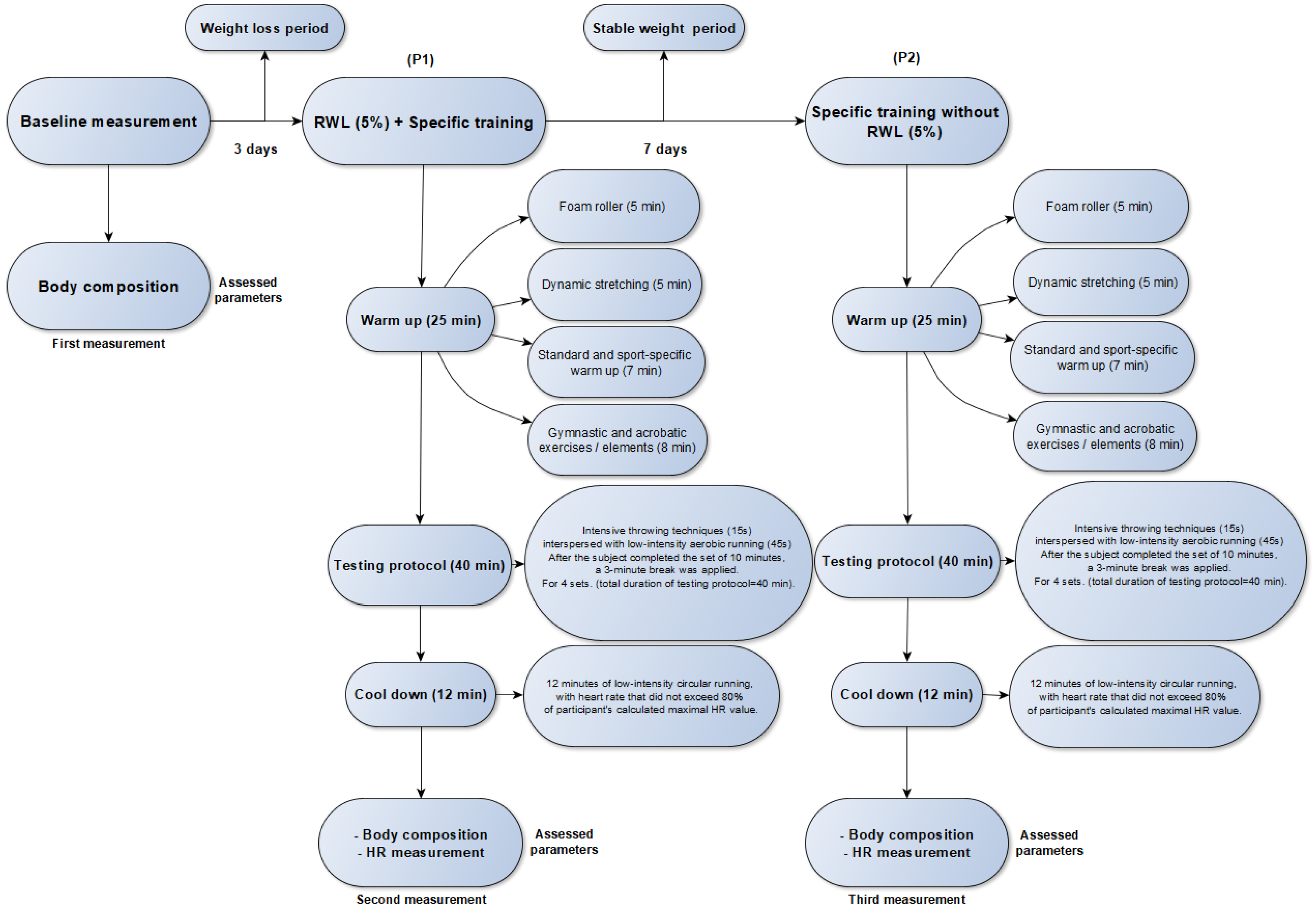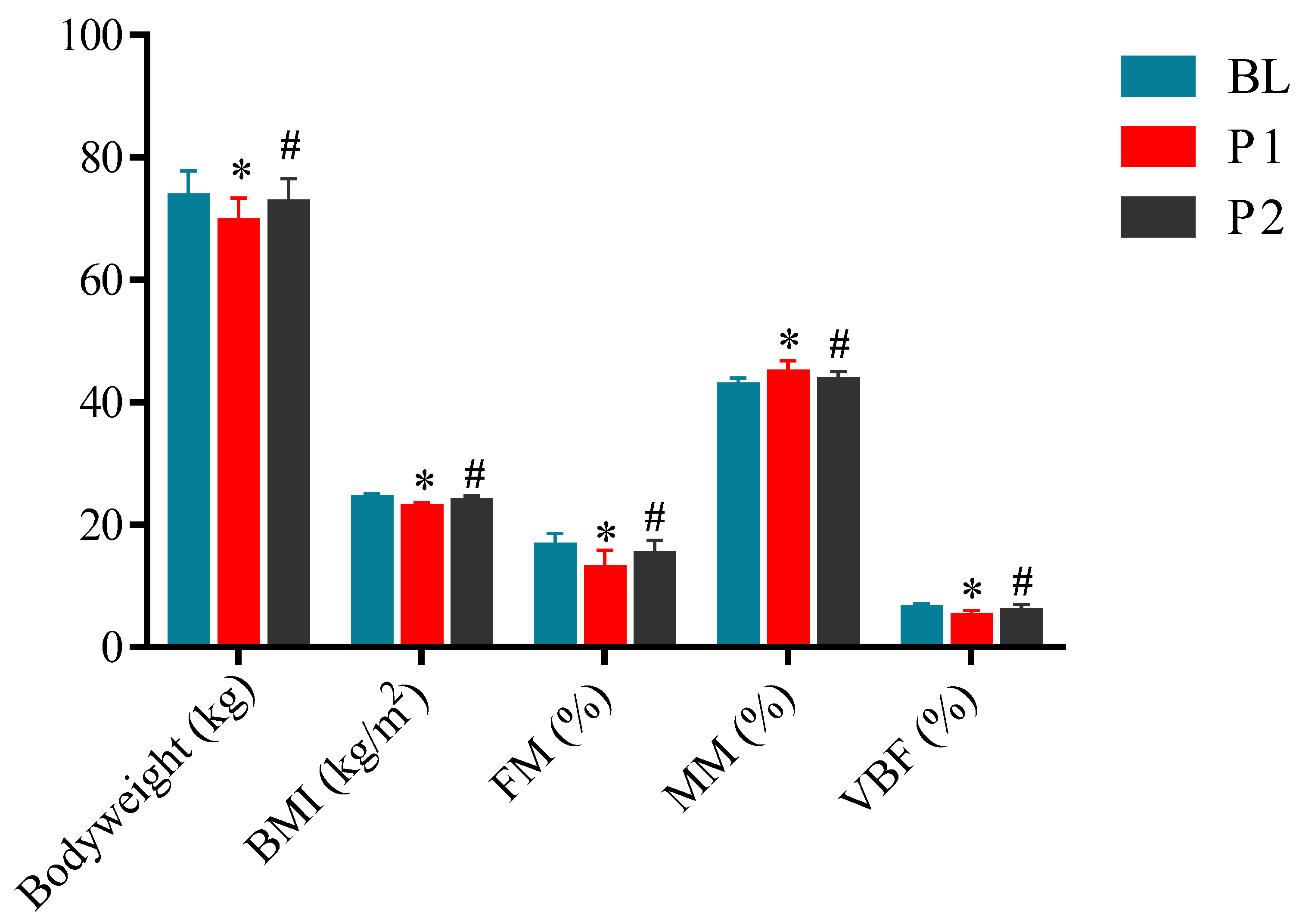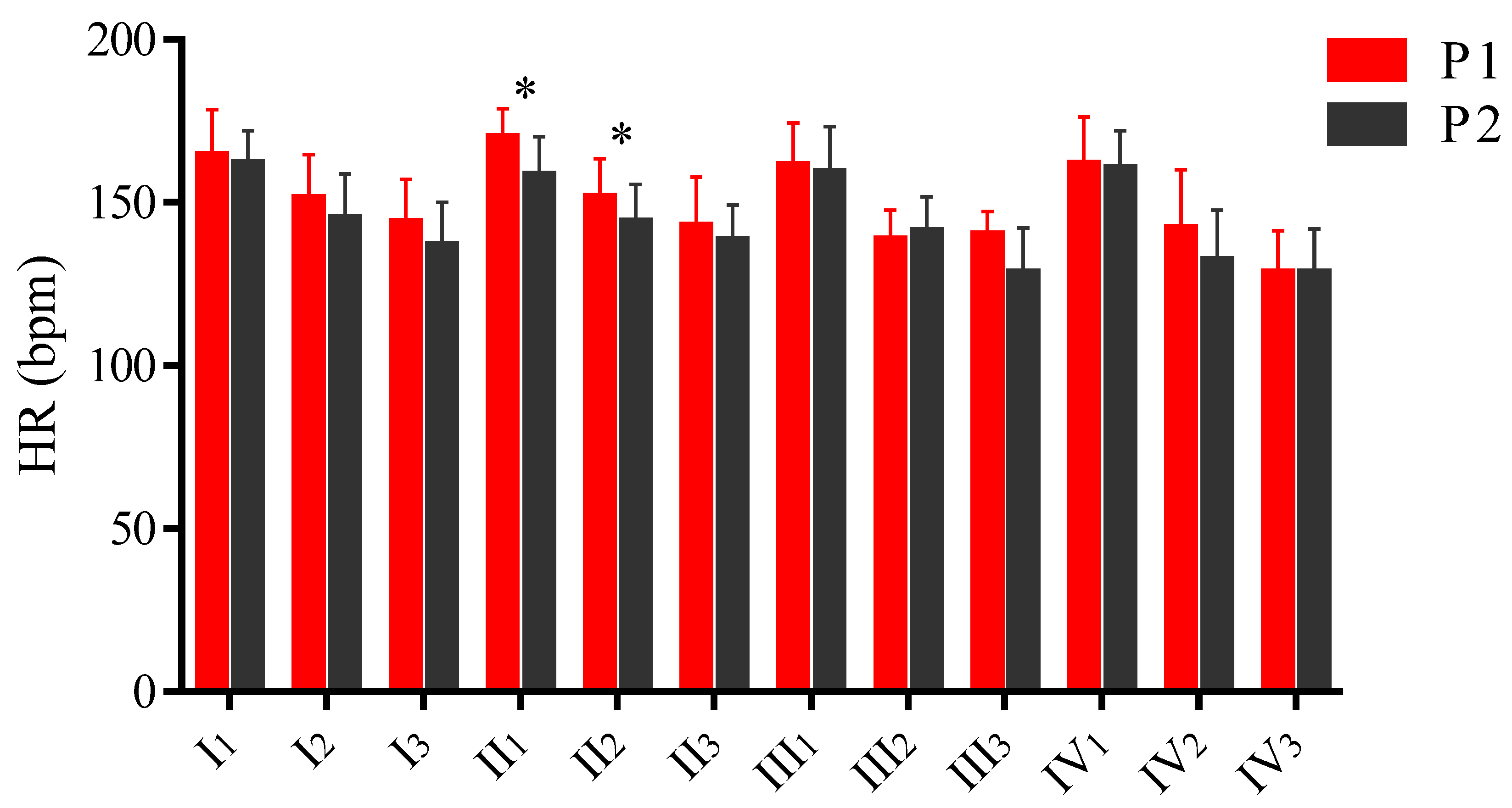Rapid Weight Loss Coupled with Sport-Specific Training Impairs Heart Rate Recovery in Greco-Roman Wrestlers
Abstract
1. Introduction
2. Materials and Methods
2.1. Participants
2.2. Testing Protocol High-Intensity Sport-Specific Training (HISST)
2.3. Warm-Up
2.4. Testing Protocol
2.5. Cooldown
2.6. Statistical Analysis
3. Results
4. Discussion
5. Conclusions
Author Contributions
Funding
Institutional Review Board Statement
Informed Consent Statement
Acknowledgments
Conflicts of Interest
References
- Nilsson, J.; Csergö, S.; Gullstrand, L.; Tveit, P.; Refsnes, P.E. Work-time profile, blood lactate concentration and rating of perceived exertion in the 1998 Greco-Roman Wrestling World Championship. J. Sports Sci. 2002, 20, 939–945. [Google Scholar] [CrossRef]
- Horswill, C.A.; Miller, J.E.; Scott, J.R.; Smith, C.M.; Welk, G.; Van Handel, P. Anaerobic and aerobic power in arms and legs of elite senior wrestlers. Int. J. Sports Med. 1992, 13, 558–561. [Google Scholar] [CrossRef]
- García-Pallarés, J.; López-Gullón, J.M.; Muriel, X.; Díaz, A.; Izquierdo, M. Physical fitness factors to predict male Olympic wrestling performance. Eur. J. Appl. Physiol. 2011, 111, 1747–1758. [Google Scholar] [CrossRef] [PubMed]
- Demirkan, E.; Koz, M.; Kutlu, M.; Favre, M. Comparison of Physical and Physiological Profiles in Elite and Amateur Young Wrestlers. J. Strength Cond. Res. 2015, 29, 1876–1883. [Google Scholar] [CrossRef] [PubMed]
- Morales, J.; Alamo, J.M.; García-Massó, X.; Buscà, B.; López, J.L.; Serra-Añó, P.; González, L.M. Use of heart rate variability in monitoring stress and recovery in judo athletes. J. Strength Cond. Res. 2014, 28, 1896–1905. [Google Scholar] [CrossRef] [PubMed]
- Yoon, J. Physiological profiles of elite senior wrestlers. Sports Med. 2002, 32, 225–233. [Google Scholar] [CrossRef] [PubMed]
- Franchini, E.; Yuri Takito, M.; Yuzo Nakamura, F.; Ayumi Matsushigue, K.; Peduti Dal’Molin Kiss, M.A. Effects of recovery type after a judo combat on blood lactate removal and on performance in an intermittent anaerobic task. J. Sports Med. Phys. Fit. 2003, 43, 424–431. [Google Scholar]
- Muramatsu, S. The relationship between aerobic capacity and peak power during intermittent anaerobic exercise of judo athletes. Bull. Assoc. Sci. Study Judo Kodokan 1994, 8, 151–160. [Google Scholar]
- Coote, J.H.; Bothams, V.F. Cardiac vagal control before, during and after exercise. Exp. Physiol. 2001, 86, 811–815. [Google Scholar] [CrossRef]
- Raven, P.B.; Fadel, P.J.; Ogoh, S. Arterial baroreflex resetting during exercise: A current perspective. Exp. Physiol. 2006, 91, 37–49. [Google Scholar] [CrossRef] [PubMed]
- Borresen, J.; Lambert, M.I. Autonomic control of heart rate during and after exercise: Measurements and implications for monitoring training status. Sports Med. 2008, 38, 633–646. [Google Scholar] [CrossRef] [PubMed]
- Ostojic, S.; Calleja-Gonzalez, J.; Jakovljevic, D.; Vucetic, V.; Ahumada, F. Ultra short-term heart rate recovery in athletes of different sports. Med. Sport 2010, 63, 145–152. [Google Scholar]
- Cole, C.R.; Blackstone, E.H.; Pashkow, F.J.; Snader, C.E.; Lauer, M.S. Heart-rate recovery immediately after exercise as a predictor of mortality. N. Engl. J. Med. 1999, 341, 1351–1357. [Google Scholar] [CrossRef]
- Lahiri, M.K.; Kannankeril, P.J.; Goldberger, J.J. Assessment of autonomic function in cardiovascular disease: Physiological basis and prognostic implications. J. Am. Coll. Cardiol. 2008, 51, 1725–1733. [Google Scholar] [CrossRef]
- Pierpont, G.L.; Stolpman, D.R.; Gornick, C.C. Heart rate recovery post-exercise as an index of parasympathetic activity. J. Auton. Nerv. Syst. 2000, 80, 169–174. [Google Scholar] [CrossRef]
- Suzic Lazic, J.; Dekleva, M.; Soldatovic, I.; Leischik, R.; Suzic, S.; Radovanovic, D.; Djuric, B.; Nesic, D.; Lazic, M.; Mazic, S. Heart rate recovery in elite athletes: The impact of age and exercise capacity. Clin. Physiol. Funct. Imaging 2017, 37, 117–123. [Google Scholar] [CrossRef]
- Chorbajian, T. Normographic approach for the estimation of heart rate recovery time after exercise. J. Appl. Physiol. 1971, 31, 962–964. [Google Scholar] [CrossRef] [PubMed]
- Ostojic, S.M.; Stojanovic, M.D.; Calleja-Gonzalez, J. Ultra short-term heart rate recovery after maximal exercise: Relations to aerobic power in sportsmen. Chin. J. Physiol. 2011, 54, 105–110. [Google Scholar] [CrossRef] [PubMed]
- Viveiros, L.; Moreira, A.; Zourdos, M.C.; Aoki, M.S.; Capitani, C.D. Pattern of Weight Loss of Young Female and Male Wrestlers. J. Strength Cond. Res. 2015, 29, 3149–3155. [Google Scholar] [CrossRef] [PubMed]
- Berkovich, B.E.; Eliakim, A.; Nemet, D.; Stark, A.H.; Sinai, T. Rapid Weight Loss Among Adolescents Participating In Competitive Judo. Int. J. Sport Nutr. Exerc. Metab. 2016, 26, 276–284. [Google Scholar] [CrossRef]
- Khodaee, M.; Olewinski, L.; Shadgan, B.; Kiningham, R.R. Rapid Weight Loss in Sports with Weight Classes. Curr. Sports Med. Rep. 2015, 14, 435–441. [Google Scholar] [CrossRef] [PubMed]
- Lakicevic, N.; Paoli, A.; Roklicer, R.; Trivic, T.; Korovljev, D.; Ostojic, S.M.; Proia, P.; Bianco, A.; Drid, P. Effects of Rapid Weight Loss on Kidney Function in Combat Sport Athletes. Medicina 2021, 57, 551. [Google Scholar] [CrossRef] [PubMed]
- Roklicer, R.; Lakicevic, N.; Stajer, V.; Trivic, T.; Bianco, A.; Mani, D.; Milosevic, Z.; Maksimovic, N.; Paoli, A.; Drid, P. The effects of rapid weight loss on skeletal muscle in judo athletes. J. Transl. Med. 2020, 18, 142. [Google Scholar] [CrossRef] [PubMed]
- Ostojic, S.M.; Markovic, G.; Calleja-Gonzalez, J.; Jakovljevic, D.G.; Vucetic, V.; Stojanovic, M.D. Ultra short-term heart rate recovery after maximal exercise in continuous versus intermittent endurance athletes. Eur. J. Appl. Physiol. 2010, 108, 1055–1059. [Google Scholar] [CrossRef]
- Stöggl, T.L.; Björklund, G. High Intensity Interval Training Leads to Greater Improvements in Acute Heart Rate Recovery and Anaerobic Power as High Volume Low Intensity Training. Front. Physiol. 2017, 8, 562. [Google Scholar] [CrossRef]
- Andreato, L.V.; Franchini, E.; de Moraes, S.M.; Pastório, J.J.; da Silva, D.F.; Esteves, J.V.; Branco, B.H.; Romero, P.V.; Machado, F.A. Physiological and Technical-tactical Analysis in Brazilian Jiu-jitsu Competition. Asian J. Sports Med. 2013, 4, 137–143. [Google Scholar] [CrossRef] [PubMed]
- Da Silva, B.V.C.; Ide, B.N.; de Moura Simim, M.A.; Marocolo, M.; da Mota, G.R. Neuromuscular responses to simulated brazilian jiu-jitsu fights. J. Hum. Kinet 2014, 44, 249–257. [Google Scholar] [CrossRef] [PubMed][Green Version]
- Buchheit, M.; Simpson, M.B.; Al Haddad, H.; Bourdon, P.C.; Mendez-Villanueva, A. Monitoring changes in physical performance with heart rate measures in young soccer players. Eur. J. Appl. Physiol. 2012, 112, 711–723. [Google Scholar] [CrossRef] [PubMed]
- Feito, Y.; Giardina, M.J.; Butcher, S.; Mangine, G.T. Repeated anaerobic tests predict performance among a group of advanced CrossFit-trained athletes. Appl. Physiol. Nutr. Metab. 2019, 44, 727–735. [Google Scholar] [CrossRef] [PubMed]
- Watson, A.M.; Brickson, S.L.; Prawda, E.R.; Sanfilippo, J.L. Short-Term Heart Rate Recovery is Related to Aerobic Fitness in Elite Intermittent Sport Athletes. J. Strength Cond. Res. 2017, 31, 1055–1061. [Google Scholar] [CrossRef] [PubMed]
- Franchini, E.; Cormack, S.; Takito, M.Y. Effects of High-Intensity Interval Training on Olympic Combat Sports Athletes’ Performance and Physiological Adaptation: A Systematic Review. J. Strength Cond. Res. 2019, 33, 242–252. [Google Scholar] [CrossRef] [PubMed]



| Baseline Values | RWL and Training Phase (P1) | Training-Only Phase (P2) | |
|---|---|---|---|
| Bodyweight (kg) | 73.36 ± 4.42 | 69.27 ± 4.12 * | 72.38 ± 4.17 # |
| BMI (kg/m2) | 24.11 ± 0.96 | 22.62 ± 0.98 * | 23.64 ± 1.07 # |
| Fat mass percentage (%) | 16.37 ± 2.22 | 12.74 ± 3.15 * | 14.98 ± 2.47 # |
| Muscle mass percentage (%) | 42.51 ± 1.41 | 44.64 ± 2.14 * | 43.36 ± 1.71 # |
| Visceral body fat (%) | 6.11 ± 1.05 | 4.88 ± 1.16 * | 5.66 ± 1.32 # |
| Basal metabolic rate (kcal) | 1717.33 ± 64.98 | 1677.11 ± 61.49 | 1704.11 ± 56.43 |
Publisher’s Note: MDPI stays neutral with regard to jurisdictional claims in published maps and institutional affiliations. |
© 2022 by the authors. Licensee MDPI, Basel, Switzerland. This article is an open access article distributed under the terms and conditions of the Creative Commons Attribution (CC BY) license (https://creativecommons.org/licenses/by/4.0/).
Share and Cite
Roklicer, R.; Rossi, C.; Bianco, A.; Štajer, V.; Maksimovic, N.; Manojlovic, M.; Gilic, B.; Trivic, T.; Drid, P. Rapid Weight Loss Coupled with Sport-Specific Training Impairs Heart Rate Recovery in Greco-Roman Wrestlers. Appl. Sci. 2022, 12, 3286. https://doi.org/10.3390/app12073286
Roklicer R, Rossi C, Bianco A, Štajer V, Maksimovic N, Manojlovic M, Gilic B, Trivic T, Drid P. Rapid Weight Loss Coupled with Sport-Specific Training Impairs Heart Rate Recovery in Greco-Roman Wrestlers. Applied Sciences. 2022; 12(7):3286. https://doi.org/10.3390/app12073286
Chicago/Turabian StyleRoklicer, Roberto, Carlo Rossi, Antonino Bianco, Valdemar Štajer, Nemanja Maksimovic, Marko Manojlovic, Barbara Gilic, Tatjana Trivic, and Patrik Drid. 2022. "Rapid Weight Loss Coupled with Sport-Specific Training Impairs Heart Rate Recovery in Greco-Roman Wrestlers" Applied Sciences 12, no. 7: 3286. https://doi.org/10.3390/app12073286
APA StyleRoklicer, R., Rossi, C., Bianco, A., Štajer, V., Maksimovic, N., Manojlovic, M., Gilic, B., Trivic, T., & Drid, P. (2022). Rapid Weight Loss Coupled with Sport-Specific Training Impairs Heart Rate Recovery in Greco-Roman Wrestlers. Applied Sciences, 12(7), 3286. https://doi.org/10.3390/app12073286













